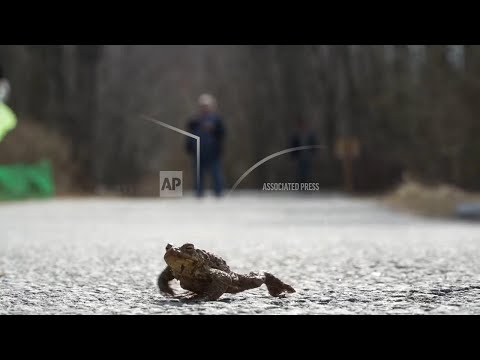(17 Apr 2025)
RESTRICTION SUMMARY:
ASSOCIATED PRESS
Leningrad region, Russia – 16 April 2025
1. Wide of road, sign reading (Russian) "Attention! Slow down! Toads are crossing the road"
2. Various of frogs in reed beds
3. SOUNDBITE (Russian) Konstantin Milta, senior researcher at the herpetology laboratory of the St. Petersburg Zoological Institute: ++STARTS ON SHOT 1++
"The toads migrate from the forest to the bay in the spring, reproduce in the reed beds in the coastal strip, lay eggs, and then, somewhere in mid-May, they leave the water and migrate back to the forest. And thus, they cross this road twice."
4. Volunteers catching toad in bucket
5. Volunteer showing toad and releasing it UPSOUND (Russian) volunteer, no name given: "So cute! Clings to it (the palm) with its finger."
6. Instructor talking to volunteers UPSOUND (Russian) instructor, no name given: "Be especially careful if the grass is high and there are leaves, watch your feet, you can remove the top layer this way, because sometimes they hide under the leaves."
7. Volunteer catching toad in bucket and carrying it over road
8. Frog on road
STORYLINE:
A couple dozen volunteers clad in yellow vests and textile gloves on Wednesday patrolled a road just outside St. Petersburg, Russia’s second largest city.
They were looking for frogs and toads heading across the asphalt towards their spawning sites in a nearby body of water, picking them up and carrying them across the road onto the grass, where they wouldn’t be hit by cars.
There usually aren’t that many on this particular section of the road in the Sestroretsk Bog natural reserve, north of St. Petersburg, but the relatively slow traffic still killed up to 1,000 toads, said Konstantin Milta, senior researcher with the St. Petersburg Zoological Institute.
“On large highways, the death rate is monstrous. Sometimes the surface of the road can be covered with a layer of dead animals,” Milta told the Associated Press.
According to Milta, in the Sestroretsk Bog reserve, “toads migrate from the forest to the bay in the spring, reproduce in the reed beds in the coastal strip, lay eggs, and then, somewhere in mid May, they leave the water and migrate back to the forest.”
“So they cross this road twice,” he said.
Volunteers have been helping carry toads and frogs across the road since 2016, said Viktoria Samuta, head of the environmental education section of the Directorate of Protected Areas of St. Petersburg.
Depending on weather conditions, this work begins in mid April and is continued for a month or two, she said, and more than 700 volunteers take part every year.
===========================================================
Clients are reminded to adhere to all listed restrictions and to check the terms of their licence agreements. For further assistance, please contact the AP Archive on: Tel +44(0)2074827482 Email: info@aparchive.com.
Find out more about AP Archive: http://www.aparchive.com/HowWeWork
Twitter: https://twitter.com/AP_Archive
Facebook: https://www.facebook.com/APArchives
Instagram: https://www.instagram.com/APNews/
You can license this story through AP Archive: http://www.aparchive.com/metadata/youtube/889db74bebfb4db7ac2d3791068b7fcf
Author: AP Archive
Go to Source
News post in April 22, 2025, 12:05 pm.
Visit Our Sponsor’s:
News Post In – News





